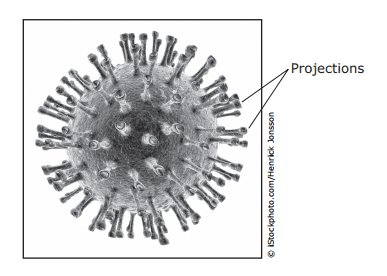
TEKS HS Biology - BIOL.4C Viruses
Quiz by Biology - Texas Education Agency
High School
Biology(2017)(ARCHIVED)
Texas Essential Knowledge and Skills (TEKS)
Feel free to use or edit a copy
includes Teacher and Student dashboards
Measures 1 skill from
Measures 1 skill from
Track each student's skills and progress in your Mastery dashboards
With a free account, teachers can
- edit the questions
- save a copy for later
- start a class game
- automatically assign follow-up activities based on students’ scores
- assign as homework
- share a link with colleagues
- print as a bubble sheet
12 questions
Show answers
- Q1A photograph of a virus is shown below. The projections on the surface of this virus allow the virus to -control a host cell's DNAsignal other viruses to infect a host cellmove inside a host cellattach to a host cell60sBIOL.4c
- Q2Cold sores are caused by the herpes simplex virus type 1. A company that wants to develop antiviral drugs would ask a research immunologist to study -the mechanism used by the virus to infect cellshow closely related the virus is to cold virusesthe metabolism of the virusmeiosis in the virus60sBIOL.4c
- Q3A person infected with the human immunodeficiency virus (HIV) may not have any symptoms for a period of time. During this period the virus affects the body by doing which of the following?The virus damages immune cells while using their machinery to produce copies of itself.The virus produces toxins that weaken immune cells and prevent them from reproducing.The virus changes the identity of the nucleotides of immune cells to prevent the immune system from functioning normally.The virus uses nutrients meant for immune cells to fuel its own cellular respiration.60sBIOL.4c
- Q4Severe acute respiratory syndrome (SARS) is an illness caused by a coronavirus. Symptoms including a high fever, headaches, and body aches typically occur two to seven days after infection by the virus. SARS is more serious in elderly patients. This information suggests that the reproductive cycle of the SARS virus is -lysogenic, because the virus is a coronaviruslysogenic, because the virus primarily affects older peoplelytic, because of the quick onset of symptoms after infectionlytic, because the virus causes respiratory illness60sBIOL.4c
- Q5Models of the human immunodeficiency virus (HIV) and an animal cell are shown below. What is the difference in the function of the glycoprotein structures of an HIV virion and the cilia of an animal cell?The glycoprotein structures are used to provide physical support for the viral envelope, and the cilia strengthen the cell membraneThe glycoprotein structures are used for attachment, and the cilia are used to move fluids surrounding the cellThe glycoprotein structures are used to obtain nutrition, and the cilia are used to secrete proteinsThe glycoprotein structures are used for defense, and the cilia are used for locomotion60sBIOL.4c
- Q6H1N1 flu is a highly contagious viral infection caused by the influenza A (H1N1) virus. The symptoms of H1N1 flu are listed in the box below. An antiviral agent administered within 48 hours of the appearance of symptoms can reduce the severity of the illness. Why is it important to administer an antiviral agent to an infected person within 48 hours of the appearance of symptoms?The H1N1 virus replicates quicklyThe H1N1 virus is dormant in cellsThe H1N1 virus does not mutateThe H1N1 virus is transmitted through a vector host, such as a mosquito60sBIOL.4c
- Q7The 1918 influenza epidemic killed between 50 million and 100 million people worldwide. This epidemic happened near the end of World War I. More people died from the influenza epidemic than were killed in the war. Which of the following explains why this virus was so deadly worldwide?All of the aboveFood was scarce because of the war, so people were undernourished, and their immune systems were weakenedMedical personnel often became ill as a result of exposure to airborne virus particlesInfected soldiers returning from the war spread the virus when they coughed60sBIOL.4c
- Q8The picture shows a 3-D model of a virus called a bacteriophage. Bacteriophages can infect bacteria such as E. coli. In what way are the bacteriophage and E. coli alike?They have identical genomesThey contain antibodiesThey lack membrane-bound organellesThey reproduce by mitosis60sBIOL.4c
- Q9The human immunodeficiency virus (HIV) often infects and destroys CD4 T cells. These CD4 T cells are one of many kinds of white blood cells that are an important part of the immune system. The most common danger related to the destruction of CD4 T cells is -an increase in the threat of diseases caused by microorganisms and virusesan increase in the risk of high blood pressurea decrease in the flow of blood to vital organsa decrease in the amount of oxygen being transported to tissues60sBIOL.4c
- Q10Viruses can be transmitted through air, water, food, insect bites, and direct skin contact. Once a virus gains entry to the body, it invades a host cell in order to -deactivate the host cell's defensessynthesize antibodies for defensemetabolize host proteins and growaccess cellular processes for replication60sBIOL.4c
- Q11In the 1880s, Louis Pasteur developed a method of weakening viruses. The weakened viruses could be injected into healthy individuals. How is this method effective in fighting viral diseases?The weakened viruses attach to unaffected viruses in the host and interrupt the viral reproductive cycle.The immune system develops antibodies in response to the weakened viruses.Weakened viruses are unable to enter the host organism.The rate of genetic mutation in the host is decreased due to the introduction of weakened viruses.60sBIOL.4c
- Q12Which of these describes a difference between viruses and cells?Viruses have membranes made of proteins, and cells have membranes made of nucleic acid.Cells reproduce independently, and viruses require a host to reproduce.Viruses have flagella, and cells have only cilia.Cells contain protein, and viruses contain only carbohydrates.60sBIOL.4c
